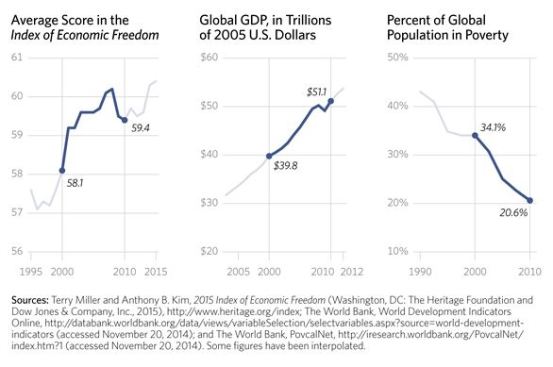The proposed 17 UN sustainable development goals (SDG) are intended to subsume the 8 Millennium Development Goals (MDG) and extend UN ambitions to sustainable development. The MDG has 169 aspirational and largely immeasurable targets. It grows like Topsy. The SDG have a similar propensity to expand the rhetoric of economic central planning – based as it is on the discredited Agenda 21.
In contrast the Copenhagen Consensus Center has 19 smart targets that would triple or quadruple the value of development aid to 2030. The 19 targets arrived at by Nobel Prize winning economists show how to best spend $2.5 trillion in development aid that the world will spend over the next 15 years. “In a world of limited resources, we can’t do everything, so which goals should we prioritize? The Copenhagen Consensus Center provides information on which targets will do the most social good (measured in dollars, but also incorporating e.g. welfare, health and environmental protection), relative to their costs.” Copenhagen Consensus Aid can provide targeted investment to improve human circumstances only if it is not wasted chasing too many low value objectives. The reality– however – is that only economic development can provide the resources to see substantial social and environmental progress. Progress on social resilience and environments happens organically as nations become more prosperous. Prosperity is linked to economic freedom.
Source: 2015 Index of Economic Freedom
“It is no coincidence that the increase of economic liberty over the past decades has coincided with a massive reduction in worldwide poverty, disease, and hunger. The link between economic freedom and development is clear and strong. People in economically free societies live longer. They have better health. They are able to be better stewards of the environment, and they push forward the frontiers of human achievement in science and technology through greater innovation.”
The rational management of economies requires interest rates to be managed through the overnight cash market to restrain inflation to a 2%-3% target. Markets need fair, transparent and accessible laws. Including on open and fair markets. Optimal tax take is some 23% of GDP and budgets are balanced. Markets operate best in an environment of economic freedom. These nuts and bolts of market management keep economies on a stable growth trajectory – as much as is possible.
The first UN goal is to eliminate poverty. The significant impediment to poverty reduction is imagining that capitalist markets are knowable, predictable and can be arbitrarily ordered by central planners. Creeping tax takes, overspending by government, printing money, keeping interest rates too low for too long, or too high for too long, taxing primary inputs, implementing market distorting subsidies, restricting trade — the scope for poverty perpetuating market distortions are endless.
Poverty alleviation comes with economic growth as an outcome of economic freedom. The basis for all social and environmental progress is economic growth, robust democracies and bottom up – rather than UN down – approaches to global environments. Bottom up ‘polycentric’ approaches rely on the most modern theories and models of human behaviour to recreate the strategies that have worked in the past. As Nobel Prize winner in economic Elinor Ostrom said – it is applying complex and messy human solutions to complex problems of society and the environment.
Economic freedom fuels technological innovation and economic growth provides resources for the “creative destruction” of capitalism and the transition to more modern and efficient productive systems. Cheap energy powers sustained economic growth – and emissions from fossil fuels are not in principle an externalities problem. We can – in theory at least – increase the cost of energy with taxes and caps to achieve energy substitution – something seemingly at odds with poverty alleviation. Or we can decrease the cost of low carbon energy sources through technological innovation. The latter is a better way to go – and the relevant price of an energy transition is thus negative. “The key to solving for both climate and poverty is helping nations build innovative energy systems that can deliver cheap, clean, and reliable power.” Our High Energy Planet
The problem with the UN goals is that they are not sufficiently focused to do the most good with the available resources. These are not at any rate resources that are at the disposition of the UN. The $2.5 trillion is for the most part nation to nation transfers and will remain that way. It is moreover a drop in the bucket of what is needed. Most progress will come only with economic growth – and this will have very little to do with the UN until they recognise the centrality of economic freedom to social and environmental progress.
Economic growth provides resources for solving problems – restoring organic carbon in agricultural soils, conserving and restoring ecosystems, better sanitation and safer water, better health and education, updating the diesel fleet and other productive assets to emit less black carbon, developing better and cheaper ways of producing electricity, replacing cooking fires with better ways of preparing food, etc. We can sequester carbon in agricultural soils and in conserved and restored ecosystems, reduce nitrous oxide and harmful tropospheric ozone and save money on fertilisers, burn methane to produce low cost electricity, reduce the strong climate effects of black carbon and the millions of premature deaths that result from cooking over open fires at the same time. Population, development, technical innovation, multiple gases and aerosols across sectors, land use change and the environment are the broader context – and here we need models of economic freedom and practical bottom up management of global environments.

